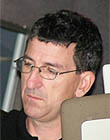|
|
This topic comprises 2 pages: 1 2
|
|
Author
|
Topic: Jittery Film
|
|
|
|
|
|
|
|
|
Ian Parfrey
Phenomenal Film Handler

Posts: 1049
From: Imbil Australia 26 deg 27' 42.66" S 152 deg 42' 23.40" E
Registered: Feb 2009
|
 posted 02-20-2009 03:43 PM
posted 02-20-2009 03:43 PM




HI James.
Some kinescope prints, due to the type of camera used to photograph the CRT, have jitter on the film itself. Due I think to the very rapid pulldown in those cameras. If my theory serves me right, the pulldown occurs during the flyback of the scanned electron beam. 25 millisecond pulldown rings a bell somewhere but Im by no means certain on that.
In light of this, I would first, I would screen the print more than once to see if the print "jitters" in the same place eveytime. This should eliminate the print being at fault.
If the jitters are random, and the Film-Guarded print still plays up, then I would agree with Monte in that gate pressure and claw condition may well be a factor.
To determine if the projector is at fault, screen the print on another projector, preferably one with an intermittant-such as a Bauer Selecton. These are a popular machine and a quick phone around the cinemas may well locate one for you to use. One was at the Village Centre in Cinema 4, one at RMIT in Queensberry St Campus, one at the Erwin Rado Cinema in Richmond. Im sure that Dave Thomas at MIFF ( Melbourne International Film Festival) will direct you. He's a top bloke.
Good luck.
| IP: Logged
|
|
|
|
|
|
|
|
Julio Roberto
Jedi Master Film Handler
Posts: 938
From: Madrid, Madrid, Spain
Registered: Oct 2008
|
 posted 02-21-2009 07:51 AM
posted 02-21-2009 07:51 AM



Only seldom I had to stabilize footage, with FCP smoothcam i.e. Only once from film with daVinci revival. Mostly had to do a bit on a short scene or two manually with motion tracking on After Effects.
Heard good things on Pixelock iStabilize software. Get their free trial and see if it works for you.
About the weird effects with the borders you mention, you have to tell filters like Steadymove what to do with them, as they would, of course, change. I.e. zoom-in-and-out, zoom to minimun, or crop the final size.
Since you are telecining yourself, if you can change aperture plates on the projector (or don't mind ruining one), you could file it down to show the film's borders. Include them in your transfer, and then motion track them with After Effects, i.e. Then just crop them or zoom-in if you need the same size as it originated in.
That would be absolutely "rock solid" to borders on film at pixel level. No software guessing the movement and possibly overshooting a bit during zooms, fast pans, etc. Only in-camera jitter would remain.
| IP: Logged
|
|
|
|
|
|
|
|
|
|
|
|
|
|
|
|
All times are Central (GMT -6:00)
|
This topic comprises 2 pages: 1 2
|
Powered by Infopop Corporation
UBB.classicTM
6.3.1.2
The Film-Tech Forums are designed for various members related to the cinema industry to express their opinions, viewpoints and testimonials on various products, services and events based upon speculation, personal knowledge and factual information through use, therefore all views represented here allow no liability upon the publishers of this web site and the owners of said views assume no liability for any ill will resulting from these postings. The posts made here are for educational as well as entertainment purposes and as such anyone viewing this portion of the website must accept these views as statements of the author of that opinion
and agrees to release the authors from any and all liability.
|

 Home
Home
 Products
Products
 Store
Store
 Forum
Forum
 Warehouse
Warehouse
 Contact Us
Contact Us




 Printer-friendly view of this topic
Printer-friendly view of this topic










